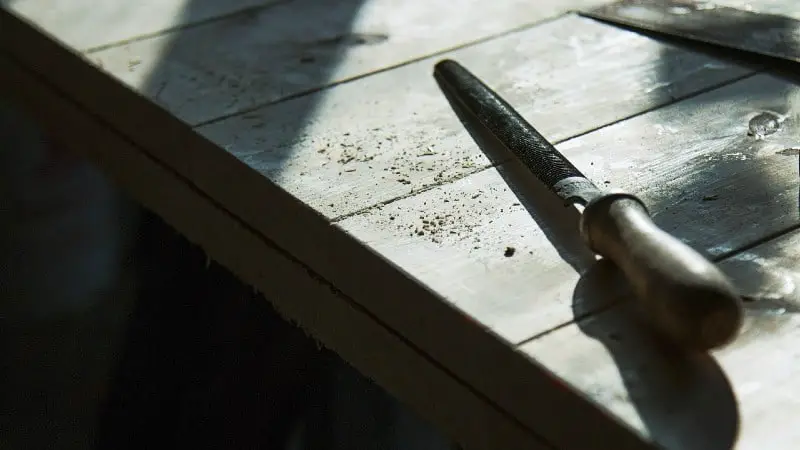When you’re just starting out in DIY and woodworking, one of the first tools you’ll want to get is a jigsaw. You might ask: What can I use instead of a jigsaw?
The jigsaw is a versatile, portable woodworking tool that can cut curves in wood and other materials. It has a reciprocating blade and is moved along the wood surface, in the direction of the curve.
The jigsaw also comes at a relatively low price point, which means that DIYers and those new to woodworking can get started right away.
Some of its uses include cutting out holes in wood for doorways or windows, cutting decorative curved shapes into furniture pieces, and cutting out complex shapes from multiple sheets of plywood. I wrote another article about 15 common mistakes when cutting plywood with a jigsaw.
So what if you don’t have a jigsaw? What can you use instead?
Several other tools can be used to cut curves in wood. These include the coping saw, scroll saw, band saw, router, and oscillating saw. As an added bonus, the router can also cut curved recesses into wood.
To give a more complete answer, I will go into more detail:
Why wouldn’t you use a jigsaw when cutting curves?
In many cases, a jigsaw is the first tool that comes to mind when you need to cut curves in wood. And for good reason—it’s an incredibly versatile tool that can make short work of many different jobs! So why wouldn’t you use one? Here are some of the reasons:
1) Your jigsaw is broken – If your jigsaw has broken down, it may not be worth fixing it. The cost of the tool itself and the cost of parts can be high. Also, if you have to pay someone to fix it, that could be more than just buying a new one.
2) You don’t own a jigsaw – If you’re just starting out in woodworking, it might not make sense for you to drop money on a tool that won’t get used often enough to make it worth buying. In another article, I discuss 5 things you didn’t know about jigsaws.
3) You have a cordless jigsaw and the battery is discharged. You don’t want to spend the time needed for recharging – This can be true if you’re running short on time and need to finish that project as soon as possible!
4) The workpiece is very thick and you don’t have a jigsaw blade long enough to cut through the wood – If this applies to your situation, then definitely consider using a bandsaw instead—it’ll probably save you some time! I wrote another article about jigsaw blade length.

Tools you can use instead of a jigsaw
We all have our favorite tools in the shop, but sometimes the tool we want isn’t available at the time. Maybe you need a jigsaw to cut out a few curves in your next project and you can’t find one. I wrote another article about how to cut a curve in wood with a jigsaw.
Or maybe you’re just starting out and don’t want to spend the money on a jigsaw. Whatever the reason, there are plenty of options for cutting curves with tools that are already in your shop:
Coping Saw
If you’ve just started woodworking or are looking to try something new, coping saws can be a great tool to add to your arsenal. These hand tools are flexible and versatile, making them an excellent option for DIYers and those new to woodworking.
The C-shaped frame holds a thin, narrow blade with pins on both ends. The pins help hold the blade in place as you move the saw back and forth to cut, so that intricate curves can be made accurately.
The coping saw blade is similar to a jigsaw blade. However, the jigsaw blade is only attached at one end. I wrote another article with 11 reasons why jigsaw blades keep breaking.
Jeweler’s saw
You get to work with your new jigsaw, but after a few days of cutting wood, it begins to feel like the tool is taking over your life. You can’t even walk by the thing without it making a horrible screeching noise!
If you need a break from power tools, try using a jeweler’s saw instead!
The jeweler’s saw is perfect for DIYers who want to do some projects around the house and in their workshops. People new to woodworking are often intimidated by power tools, but this tool is easy to use and will help you cut both metal (as with jewelry) and wood. I wrote another article with 31 helpful tips for working with a jigsaw.
The jeweler’s saw has a C-shaped frame, which makes it easy to guide your blade through curves and corners. The blades can be round or spiral in shape so that they can cut in any direction, which makes them ideal for cutting sharp curves.
Keyhole saw
Keyhole saws are great for making cuts in wood and other materials. They have a pointed end that allows you to cut curves and openings in your project. You cut with a keyhole saw by moving the blade back and forth.
Keyhole saws can be used to cut any kind of curve or opening in wood or another material. The handle is often straight, so it feels comfortable to hold and use.
A keyhole saw is a tool that you can use to cut an opening for an outlet box in drywall or paneling. It has a slim blade, which lets you cut out small or intricate shapes. I wrote another article about using a jigsaw to cut curves.
Scroll saw
If you’re looking for a substitute for your jigsaw, the scroll saw is probably the most similar tool.
It’s a powerful tool that can be used to cut intricate curves in wood, plastic, and other materials. While it needs to be mounted permanently onto your workbench (so isn’t very portable), it’s well-suited for beginning DIYers who want an easy-to-use machine without too many complications.
A scroll saw uses a thin narrow blade that moves up and down to cut through the material. The size of the sheet that you can cut is limited by the size of the arm of the scroll saw.
Fine scroll saw blades have a higher TPI (Teeth Per Inch) value. I wrote another article about the TPI of jigsaw blades.

Circular saw
The circular saw is one of the most useful tools in any DIYer’s arsenal. It’s portable, it’s versatile, and when you use it correctly, it can cut straight lines like no other power tool out there. But what if you need to cut curves?
There are a few different ways to approach this problem. If your curve is slow and gradual, then you can use the circular saw to cut tangent lines around the curve. When you’re done with these cuts, the result will not match the curve perfectly.
You can then sand the wood to the exact shape of the curve. The more lines that you cut, the closer the approximation to the actual curve and the less sanding that is required.
Oscillating tool
If you don’t have a jigsaw and you need to cut a straight line, there is another option: You can use an oscillating tool. An oscillating tool is a handheld power tool with a blade that moves back and forth rapidly. I wrote another article about T-Shank blades for a U-Shank jigsaw.
The blade is usually flat and straight so it is designed for cutting straight lines (such as the opening for an outlet box) rather than curves. So, you can use the same approach as with a circular saw, which involves cutting tangents. Then, sand the wood until it’s shaped perfectly.
Router
If you’re new to woodworking, or just getting started with a project that requires some precision cutting, a router is a great tool to have on hand. Routers are used to shape and cut wood—the bit spins at high speed, allowing it to make clean and accurate cuts in the wood. In addition to being able to shape your material however you’d like, there are many attachments available for a router that can help you accomplish even more tasks.
A router can make curved cuts partway through wood, while jigsaw blades have to cut all the way through; this is useful if you’re doing DIY work involving inlays.
Routers can be dangerous if not handled properly. Because the sharp bit spins so rapidly, care should be exercised when using it —it’s easy to lose control of the tool and injure yourself. Always wear safety goggles, ear protection, and a dust mask when using a router. Follow all instructions provided by the manufacturer for your specific model of router.
I wrote another article comparing the jigsaw to a router.

Electric drill and rotary rasp bit
If you want to sculpt smooth curves in wood or other materials, you can use an electric drill and rotary rasp bit.
The electric drill is used to make holes in wood or other materials, and it accepts numerous types of bits. Some are used to drive screws into wood while others can be used as sanding tools. The rotary rasp bit is like a file or rasp in appearance. I wrote another article cutting a hole with a jigsaw.
Cut a curve out of the material by moving the bit along the curve.
Chisel
The chisel is one of the most versatile tools in your workshop, and can be used for a variety of tasks. Whether you’re cutting curves or straight lines, a chisel can be used instead of a jigsaw or other power tool.
The chisel is just a flat piece of metal with a sharp edge (like a knife). You can use it to cut into wood or other materials by pressing down on the blade and moving it along the curve you want to cut.
The downside of using a chisel is that it takes a lot of skill to do it well—it requires precision and patience! If you’re new to woodworking and don’t have much experience with this tool yet, it can be frustrating to get everything just right.
This method might take a considerable amount of time. I wrote another article with 5 reasons why the jigsaw lets you be more productive.
Surform tool
The Surform tool is one of the most affordable and versatile tools you can use in your woodworking projects. You can use it to shape wood and sand down rough surfaces. It’s an extremely easy tool to use and is a must-have in any workshop.
It has a sharp metal bottom that is designed to cut through wood easily. The best thing about this tool is that it doesn’t require any electricity or power source. You can use it anywhere and at any time.
File
A file is a tool that helps you sand or smooth the surface of your piece of wood. It’s a great tool to use if you need to remove excess material or shape your piece into something more complex. The process is slow and can take a long time, especially if you’re working with very thick pieces of wood. However, it’s easy to learn how to use one, and with practice, you’ll be able to create beautiful pieces of woodwork.

Final Words …
The jigsaw is a great tool, but it’s definitely not the only option out there. If you have a lot of curves to cut, then a jigsaw is a good choice for you. However, if you’re just getting started with woodworking and don’t want to invest in a jigsaw yet, then there are other tools that can help you make those curves.
Want to know more? I wrote another article called: What is a Jigsaw?
If you’re working on a budget or just want to start small, then try out some of these alternatives:
- A coping saw (easy to use).
- A jeweler’s saw (used for metal, wood, and other materials)
- A keyhole saw (flexible and inexpensive)
As for power tools, the following can be used instead of the jigsaw:
- A scrollsaw (for intricate and precision work)
- A bandsaw (can cut thick pieces of wood)
- A router (can plunge partway through wood)
In conclusion, it’s important to know what tools are available to you and how they can be used. The more tools you have, the more options there are for your projects.
Did you enjoy reading this article? If so, you might be interested in my Pinterest profile. It contains pins about Woodworking, DIY & Crafts, Tools, Projects, Hardware, and many more topics!


